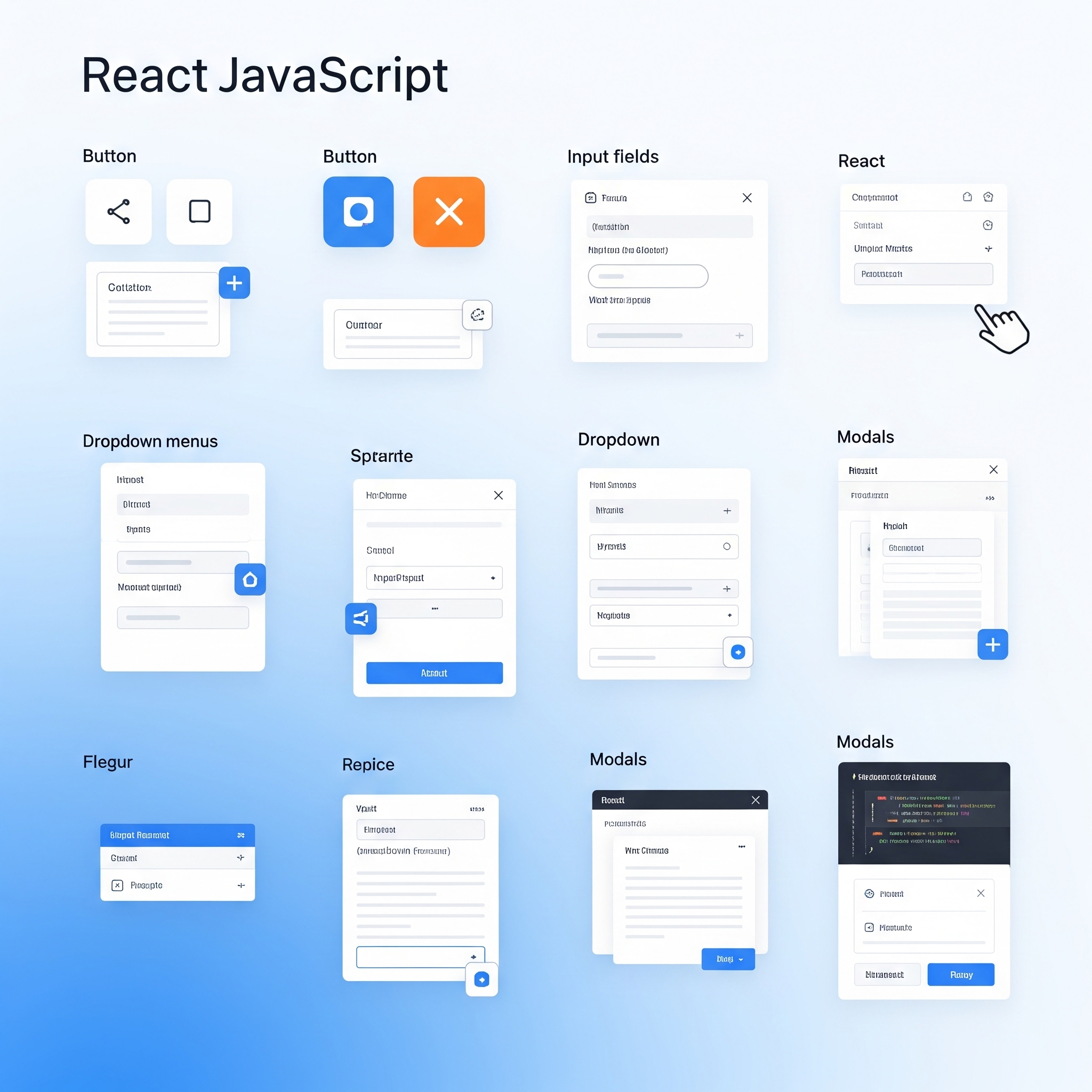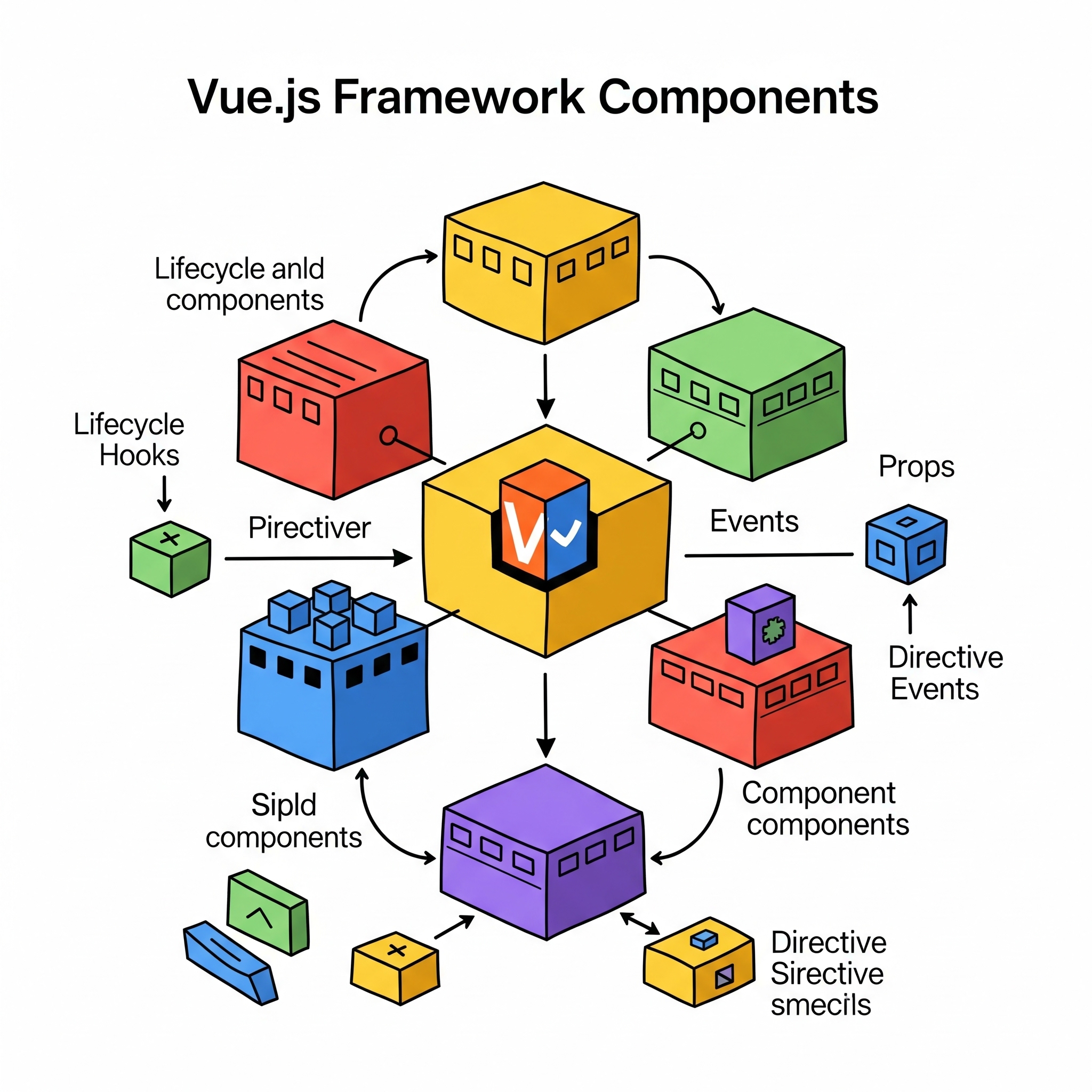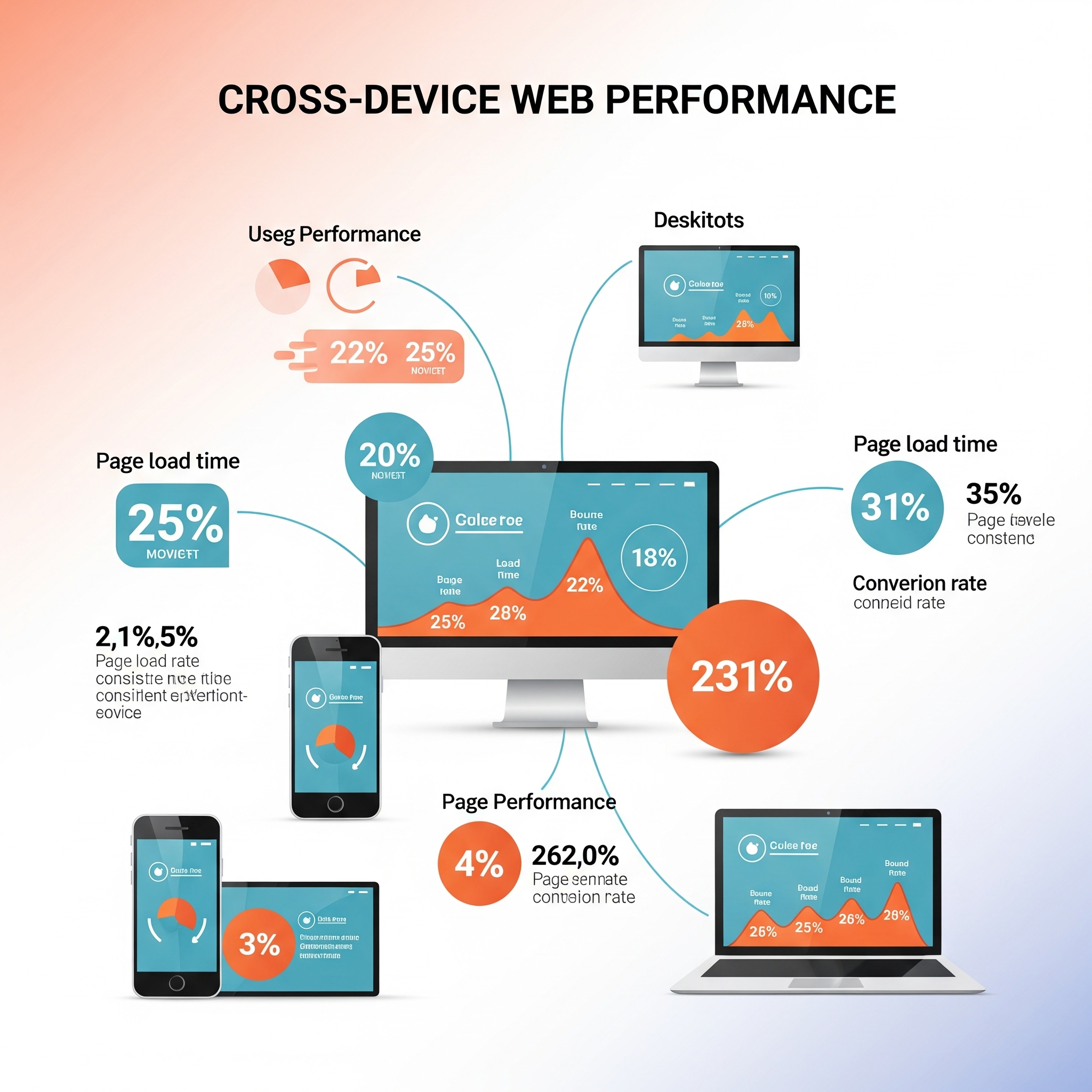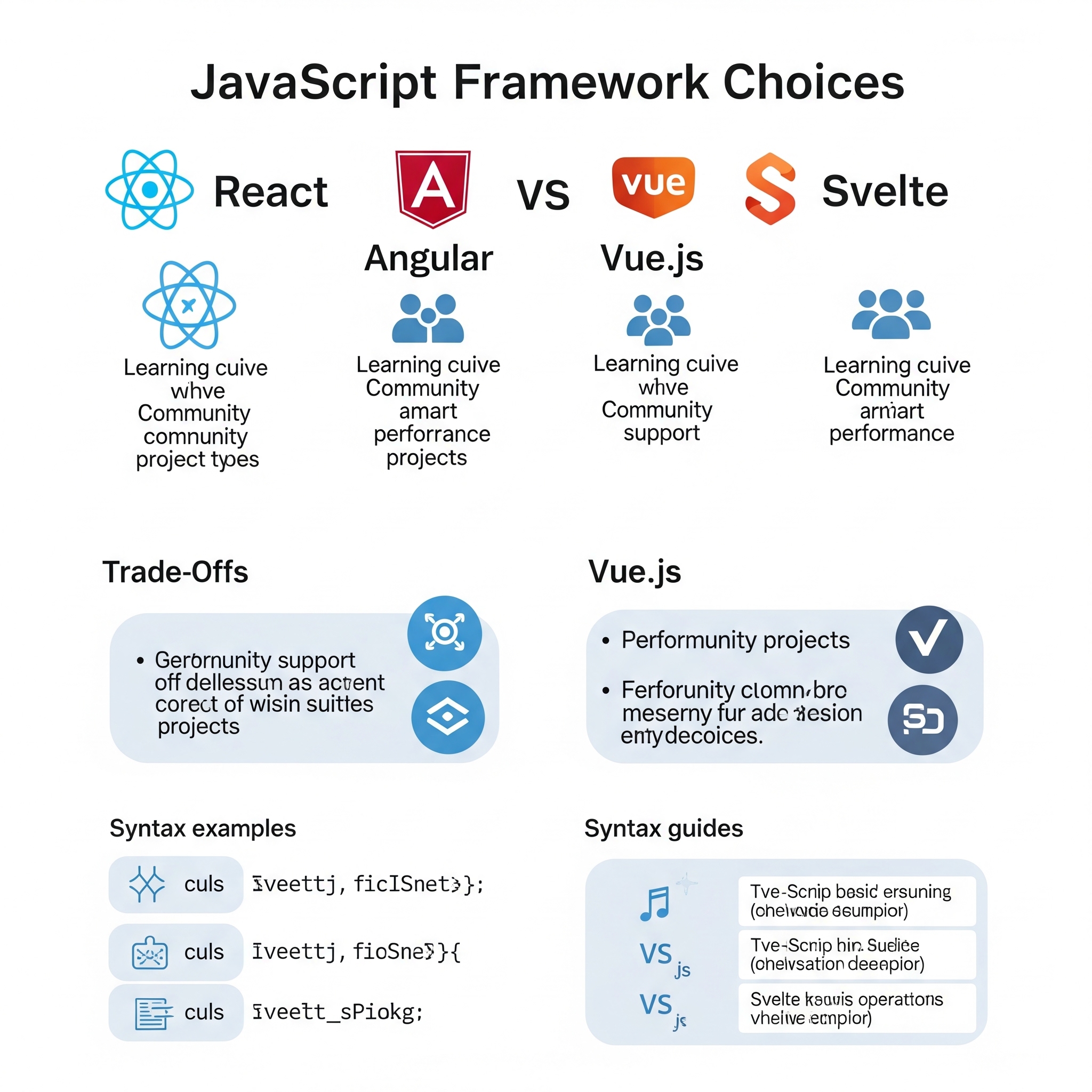2025-6-6
In modern web development, selecting the right framework is crucial to the success of your projects. Angular, React, and Vue.js are three prominent JavaScript frameworks that provide robust tools and features for building dynamic web applications.
Angular is a popular JavaScript framework developed by Google that is widely used for building large-scale, enterprise applications. With built-in support for TypeScript, Angular provides a comprehensive set of tools including routing, form validation, HTTP client, and a powerful CLI.

Angular's opinionated structure can lead to a steep learning curve, but this framework excels in maintaining structure and consistency across large projects.
React is a flexible JavaScript library developed by Facebook, known for its efficient component-based architecture. React is widely adopted for building user interfaces and mobile applications with React Native.

React provides a balance between flexibility and power, making it a popular choice for projects of any size, though it may require additional libraries to cover all aspects of development.
Vue.js is a progressive JavaScript framework designed for building user interfaces. It is appreciated for its simplicity and ease of integration into projects of any size.

Vue's gentle learning curve and clear structure make it a great choice for small to medium applications, with the simplicity of HTML, CSS, and JavaScript.
Architecture patterns like Flux, MVC, and MVVM influence the performance and maintainability of applications built with Angular, React, or Vue.
Flux facilitates a unidirectional data flow, simplifying the state management process, making debugging easier, and enhancing the predictability of application behavior.
MVC offers a modular structure segregating data handling, UI, and logic, improving code maintainability and scalability across different frameworks.
Continual advancements aim to enhance performance and developer experience across Angular, React, and Vue. These frameworks adapt to new challenges by improving optimization techniques, expanding community support, and evolving features like server-side rendering.
The community support and ecosystem surrounding each framework are crucial factors in determining their sustainability and innovation potential. Angular, React, and Vue boast extensive communities that contribute to open-source projects, plugins, and educational resources.
Angular's strong backing by Google provides a solid foundation in terms of updates and enhancements, ensuring longevity and reliability. The Angular ecosystem consists of multiple extensions and third-party tools that facilitate rapid development and deployment of complex applications. Angular Material is an official component library that supports Material Design, offering numerous UI components to create visually cohesive applications. The Angular CLI offers powerful commands for scaffolding, testing, and building applications, making it a robust environment for development.
React's vast community is one of its greatest strengths. Thanks to its widespread usage, developers can find myriad tutorials, forums, and pre-built components to accelerate project development. The ecosystem also includes a wealth of supporting libraries such as Redux for state management, which allows applications to maintain predictable and debuggable state containers. Additionally, the community facilitates ongoing improvements, ensuring React stays at the forefront of innovation. React's open-source nature encourages diversified contributions leading to a rich selection of third-party libraries tailored to various development needs.
Though younger than Angular and React, Vue's community has grown significantly, thanks to its approachable learning curve and versatility. Vue's official libraries, such as Vue Router for navigation and Vuex for centralized state management, offer robust solutions to complement its lightweight core. Developers enjoy Vue's clear documentation and an active community that provides a plethora of resources and plugins, ensuring ease of adoption and versatility in creating custom solutions for different types of projects.
In today's resource-abundant device landscape, ensuring seamless performance across smartphones, tablets, and desktops is essential. Each framework provides unique strategies to optimize performance on various devices, catering to an audience that demands fast, responsive applications regardless of their chosen platform.
Angular's built-in tools provide mechanisms to optimize performance across devices immediately after setup. Features such as Ahead-of-Time (AOT) compilation and lazy loading allow faster rendering times and minimize payload sizes, ensuring web applications deliver smooth experiences even over limited-bandwidth connections. With service workers, Angular enables offline support and background synchronization, making it particularly suitable for Progressive Web Apps (PWAs).
React’s design focuses on optimizing rendering paths through its component-based architecture and Virtual DOM. By updating only those parts of the user interface that change, React reduces the number of actual DOM manipulations, resulting in snappy user experiences. Using Memoization techniques with React.memo and libraries like React.lazy, developers can implement code-splitting and lazy loading, further reducing load times and bandwidth consumption, especially for single-page applications (SPAs).
Vue excels in performance due to its lightweight nature and efficient rendering system. Its reactive data-binding system minimizes the overhead typically associated with UI changes, resulting in quick updates and faster load times. Vue provides advanced tools like vue-cli-service and plugins that facilitate performance optimization through tree-shaking and code-splitting, making it an excellent choice for projects requiring efficient resource usage.

Determining the appropriate framework often depends on the specific needs of a project, including the scale, desired features, and the skill set of the development team. The choice impacts not only the development process but also the application's maintainability and evolution over time.
Angular is the go-to framework for projects that necessitate a comprehensive solution with out-of-the-box setup, especially relevant in large enterprise environments. Its ability to scale, paired with predefined integrations for routing, forms, and HTTP requests, minimizes the need for third-party solutions. The MVC structure is well-suited for applications requiring complex business logic where maintainability and strict coding standards are paramount.
React is preferred for applications requiring high flexibility and component reusability, making it suitable for interactive or user-focused interfaces such as social media platforms or engaging web applications. Its capabilities extend into mobile development with React Native, providing a consistent developer experience across web and mobile platforms. React's growing ecosystem enables expansive customization, making it a powerful tool for both startups and established companies aiming to innovate quickly.
Vue's gradual adoption approach makes it an excellent choice for incrementally enhancing existing applications, minimizing disruption. It's particularly advantageous for smaller to medium-sized projects that benefit from a lightweight framework, such as single-page applications and MVVM architecture-driven applications. Vue's gentle learning curve is ideal for organizations aiming to accelerate adoption while maintaining productivity and output quality.

Migrating from one framework to another can be a significant undertaking, often driven by changing business requirements, technological advancements, or the availability of better-suited frameworks. Proper planning and strategic execution are vital to ensure successful transitions that enhance rather than disrupt existing workflows.
Migrating from Angular to React may be considered when projects need more flexible components and modularity. Prioritize understanding React’s unidirectional data flow and how best to leverage its ecosystem. The transition involves rethinking concepts such as two-way data binding, transitioning to component lifecycle methods, and effectively using JavaScript ES6+ features present in React.
Organizations transitioning from Vue to Angular might be driven by the need for stricter organization and heightened scalability provided by Angular’s more structured architecture. This migration may entail adjusting to Angular's comprehensive TypeScript-based ecosystem, training teams on the MVC paradigm, and possibly tackling the steeper learning curve associated with Angular’s extensive toolset and sophisticated build process.
Vue appeals to teams seeking simplicity and ease of use, with projects transitioning from React benefiting from Vue's straightforward syntax and build processes. The transition is smooth due to both frameworks sharing component-based architectures, allowing for a seamless re-mapping of UI components while taking advantage of Vue's two-way data binding and simpler, more intuitive configuration options.
In the evolving landscape of web development, the choice between Angular, React, and Vue.js should be guided by a project's complexity, team expertise, and long-term goals. Angular provides a comprehensive, structured framework ideal for enterprise-scale applications; React offers unmatched flexibility and a robust ecosystem suited for dynamic, user-centric experiences; and Vue excels in simplicity and performance, making it perfect for lightweight, scalable solutions. By aligning the strengths of each framework with specific project needs, developers can create maintainable, high-performance applications that adapt to modern web demands and future innovation.